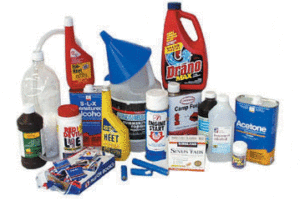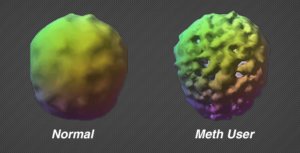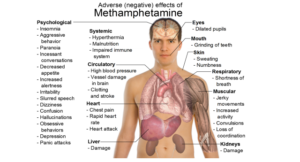Aug 28, 2011 | By Tim Stoddart
What Is Methamphetamine? – How Does It Effect The Body and Brain?
Methamphetamine Addiction
Methamphetamine Street Names
Crank, speed, tweak, amp, blue belly, crystal, white cross, trash, working man’s cocaine
Overview
Methamphetamine is one of the most vicious and dangerous drugs on the market. It is a highly addictive and potent stimulant that affects the central nervous system of those who use the drug. Meth comes in a white crystalline powder that is odorless, tasteless, and easily dissolves in water or alcohol. Meth is a synthetic drug that is commonly manufactured in large, illegal laboratories but can also be made in smaller laboratories based in abandoned buildings and other dwellings. Within the last few years, a “shake and bake” method was developed by manufacturers in which the key ingredients used to make the drug can be created in an empty two-liter soda bottle.
 Methamphetamine is comprised of a variety of chemicals that are extremely toxic and highly flammable. The main ingredient in meth is pseudoephedrine which is commonly used in cold medications. While the “recipes” can vary, other chemicals used in the production of the drug include red phosphorus, acetone, sulfuric acid, anhydrous ammonia, and toluene among others. Many of these ingredients can be purchased at convenience and drug stores.
Methamphetamine is comprised of a variety of chemicals that are extremely toxic and highly flammable. The main ingredient in meth is pseudoephedrine which is commonly used in cold medications. While the “recipes” can vary, other chemicals used in the production of the drug include red phosphorus, acetone, sulfuric acid, anhydrous ammonia, and toluene among others. Many of these ingredients can be purchased at convenience and drug stores.
Crystal methamphetamine is a form of the drug that looks like glass fragments or shiny, bluish-white rocks. It is chemically similar to amphetamine (a drug used to treat attention-deficit hyperactivity disorder [ADHD] and narcolepsy). Meth users often go on binges where they don’t eat or sleep and continue to take methamphetamine to stay awake for days at a time.
History of Methamphetamine
Methamphetamine was first synthesized in 1919. It was initially used in the United States to treat narcolepsy and asthma in the early 1930’s. Meth use became more widespread during World War II when allied bomber pilots (as well as Japanese and German soldiers) were given the drug in order to help them fight fatigue and enhance performance. After the war, methamphetamine was made available to the Japanese public. As a result, the country experienced a meth epidemic which spread to the Western United States in the 1950’s.

Despite knowledge of it’s addictive properties, methamphetamine was marketed as a weight loss aid and as “pep pills”. Easily available, it was used as a non-medical stimulant by college students, truck drivers and athletes. Nonetheless, abuse of the drug spread. During the 1960’s, doctors in San Francisco drug clinics utilized meth injections as a treatment for heroin addiction. In the 1980’s and 1990’s, meth use became more widespread as different methods of manufacturing the drug were created. Meth use reached epidemic proportions during this time in the Midwest as well as the southwestern and western United States.
In the 1990’s, Mexican drug trafficking organizations set up large laboratories in California. While these massive labs were able to generate fifty pounds of the substance in a single weekend, smaller private labs sprung up in kitchens and apartments, earning the drug one of its names, “stove-top.” In 1996, Congress passed the “Comprehensive Methamphetamine Act” which aimed to prevent the illegal manufacture and use of the drug.
The Scope of Meth Use In The United States
According to data complied in the 2012 National Survey on Drug Use and Health, approximately 1.2 million people had reported using methamphetamine in that year, and 440,000 had reported using it in the month the survey was taken. Additionally, methamphetamine accounted for about 103,000 ER visits in 2011 and was the fourth most mentioned illicit drug in emergency room visits following cocaine, marijuana, and heroin. While these numbers had shown a decline from previous years, meth use and production currently still causes significant health and law enforcement problems in states such as Iowa, Missouri, Illinois and Oklahoma.
According to the Treatment Episode Data Set (TEDS), nationwide treatment admissions for methamphetamine abuse dropped from 8.1 percent in 2005 to 5.6 percent in 2011. The majority of primary methamphetamine admissions were male (53 percent), and about two-thirds (68 percent) were non-Hispanic Whites.
What Does Meth Do To The Brain?

Methamphetamine use can chemically alter the structure and function of the brain. This means that meth use can impair motor-skills, learning abilities, and emotional regulation. Most of the pleasurable effects from the drug are believed to result from release of high levels of the neurotransmitter, Dopamine. Methamphetamine releases approximately twelve times more dopamine than food, sex, or other pleasurable activities. The elevated release of dopamine produced by meth is also thought to contribute to the drug’s harmful effects on nerve terminals in the brain.
Unlike normal brain functionality, the dopamine that is released due to meth use is not recycled and stored for later, which in turn overstimulates the brain. Continued methamphetamine abuse can severely damage dopamine and serotonin neurons, affecting how a person feels, acts and thinks. Severe damage to these neurons could cause a user to experience symptoms of depression, paranoia and hallucinations.
Methods of Administration

Studies have shown that the subjective pleasure of drug use and the reinforcing component of addiction is proportional to the rate at which the blood level of the drug increases.
Injection – Injection of the drug can pose a list of health risks and is unquestionably the most dangerous route. Users who inject meth can feel the effects within 15-30 seconds. With this route, the user will feel an instant high that lasts between 8 and 12 hours, which cause many users to take repeated doses to remain high. Intravenous users also risk developing a pulmonary embolism, a blockage of the main artery of the lung or one of its branches, and commonly develop skin rashes. As with the injection of any drug, blood-borne diseases, such as HIV or hepatitis, can be transmitted.
Smoking – Smoking meth is the most common route of administration. This high can last between 8 and 12 hours. It is commonly smoked in glass pipes made from glass-blown Pyrex tubes or light bulbs. There is little evidence that methamphetamine inhalation results in greater toxicity than any other route of administration.
Snorting – This method allows methamphetamine to be absorbed through the soft tissue of the mucus membranes in the nose and sinuses, and then directly into the bloodstream, bypassing the liver.
Orally – Users can take the drug orally as a gel tab or tablet and can mix with water, soda, or juice. When taken orally, the drug’s effects can last anywhere between 6 and 12 hours, though the high is not as intense.
Short-Term Effects of Methamphetamine Use
In small doses, meth users experience increased alertness, escalated physical activity and decreased appetite. Depending on the amount taken and an individual’s medical history, the drug can also cause a variety of cardiovascular problems, including rapid heart rate, irregular heartbeat, and increased blood pressure. Additionally, short-term use can also lead to hyperthermia, or an increase in body temperature. High doses of the drug can lead to convulsions and can result in death if treatment is not sought.
To summarize, short-term effects of methamphetamine may include:
- Increased attention
- Decreased fatigue
- Euphoria
- Increased respiration
- Rapid and irregular heartbeat
- Hyperthermia
Long-Term Effects of Methamphetamine Use

The long-term effects of methamphetamine can have multiple negative consequences and be severe for both the body and the mind. In it’s manufacture, meth is processed using harsh chemicals. As a result, heavy use is hard on the user. Meth use constricts blood vessels and lead to a user’s skin appearing aged. The damage to blood vessels and tissue can also make it more difficult for the body to repair damage. Meth users develop open sores and abscesses which are a common hallmark of meth abuse.
Chronic abusers can experience symptoms which include significant anxiety, confusion, mood disturbances and violent behavior. Users may also exhibit a number of psychotic features including paranoia, as well as visual and auditory hallucinations. Psychotic symptoms can sometimes last for months or years after a person has quit abusing methamphetamine, and stress has been shown to precipitate a spontaneous recurrence of methamphetamine psychosis in former abusers.
Additionally, methamphetamine decreases a person’s libido and rational thought processes. Consequentially, meth users could contract sexually transmitted diseases or get other serious injuries. Meth also suppresses the appetite, so many users experience malnutrition and severe weight loss.
In short, long-term effects of methamphetamine can include:
- Psychosis (paranoia, hallucinations)
- Changes in the brain structure
- Deficits in thinking
- Memory loss
- Weight loss
- Severe dental problems
- Severe skin problems
- Hair loss
- Mood disturbances
- Death
Additionally, as meth use increases, the body’s ability to defend itself from various illnesses quickly decreases. This can lead to becoming sick more frequently and other physical consequences that can include but not be limited to: liver damage, heart disease, stroke, coma and even death.
Warning Signs

There can be several key warning signs to spot a person who may be addicted to Meth. Many of these signs include physical symptoms including:
- Skin picking – methamphetamine addicts are known to obsessively pick at their skin, often times leaving open sores to the face.
- Tooth decay – Meth causes salivary glands to dry out, which allows the mouth’s acid to eat away at tooth enamel resulting in tooth decay. This is commonly referred to as “meth mouth.”
- Hair Loss – Hair loss can occur due to the lack of nutrients in an addict’s body as well as the dangerous chemicals they ingest.
- Skin Crawling – Meth addicts often complain as having crawling skin. This is known as formication.
- Tweaking – Repeatedly taking meth can keep individuals sleeping for well over a week. They often keep consuming more of the drug to stay awake, but are in many cases are unable to capture the same euphoric effects of the first hit. This concept of meth use is known as “tweaking.” While tweaking the user is likely to engage in simple repetitive tasks. These tasks can include taking something apart and putting them back together again, or cleaning his or her room repeatedly.
Methamphetamine “Comedown”
A comedown from methamphetamine is particularly different from withdrawal, however they do have common characteristics. Withdrawal from meth is most likely not potentially physically damaging unless the person becomes extremely emotionally unstable and engages in self-harm.
Comedowns are caused by a combination of neurotransmitter imbalances in the brain, chemicals metabolized into toxins that build up in the body, and exhaustion from the euphoria of the drug. Comedowns from drugs are similar to hangovers from alcohol, though can be severe.
Comedown symptoms may include:
- Fatigue
- Muscle weakness
- Anxiety
- Depression
- Lack of motivation
- Headache
- Insomnia despite exhaustion
Comedown symptoms may last for a few days after one abuses the drug. It is important to understand the symptoms of a comedown from stimulant drugs like meth because many people who begin to abuse these drugs take more as the comedown symptoms begin to set in. This can lead to a bincge, which can cause a deadly overdose or long-term harm to the brain and body.
Overdose
When an individual overdoses on meth, the body begin’s to work overtime by pumping blood through the heart. The already elevated heart rate and blood pressure can skyrocket, potentially causing a heart attack or stroke. The body can then go into shock or coma, causing irreversible damage.
There can be two types of methamphetamine overdoses:
An acute overdose happens when a person uses a large amount of meth one time and experiences an adverse reaction. Acute overdoses are potentially fatal in some cases.
A chronic overdose refers to the cumulative, negative health effects of ongoing methamphetamine abuse.
Common signs of a meth overdose can include:
- Englared pupils
- Chest pains
- Heart attack
- Kidney failure
- Stomach pain
- Altered mental status
- Paranoia
Treatment For Methamphetamine Addiction
 When a person is in the grips of a methamphetamine addiction, getting the drug becomes far more important than keeping up with simple priorities like school or work. Meth users may suffer from poor judgement and engage in a risky lifestyle or hazardous sexual behavior. A period of heavy meth use is generally followed by a crash in which a person cannot control his or her sleepiness. There will be heavy drug cravings during this time period that can lead to another binge.
When a person is in the grips of a methamphetamine addiction, getting the drug becomes far more important than keeping up with simple priorities like school or work. Meth users may suffer from poor judgement and engage in a risky lifestyle or hazardous sexual behavior. A period of heavy meth use is generally followed by a crash in which a person cannot control his or her sleepiness. There will be heavy drug cravings during this time period that can lead to another binge.
Are You or A Loved One Addicted to Meth? Sober Nation Will Help You Find Recovery
When people try meth they usually don’t think they will become addicted. They often start using meth recreationially at social gatherings, however, before long they begin using it alone. As time passes they find they are unable to stop.
Methamphetamine addiction has devastating impacts on the user as well as their family, friends and community. If you or a loved one is struggling with meth abuse, it is critical to find the resources, treatment, and support you need to overcome your addiction and reclaim your life.
Sober Nation will provide you the help that you need while treating you or your loved one with the compassion and respect they deserve. Some of the expert staff of Sober Nation are recovering addicts themselves and are an active part of the recovery community around you, so they understand the pain and frustration that you experience. Turn your goal of recovery into reality and call Sober Nation today.

mary Jayne ward
9 years ago
I’ve only shot meth once and its an awesome feeling so I can see how it can become addictive so easily …. I’m just afraid of all those chemicals …. If it its through toilet tile stains them what’s it doing to your veins? No way ! I may be a junkie but ill stick to my 30’s until I can find a way to get help and stay clean and sober ….
mary Jayne ward
9 years ago
I’ve only shot meth once and its an awesome feeling so I can see how it can become addictive so easily …. I’m just afraid of all those chemicals …. If it eats through toilet tile stains then what’s it doing to your veins? No way ! I may be a junkie but I’ll stick to my 30’s until I can find a way to get help and stay clean and sober ….
Tammy wright
9 years ago
I am a recovering meth addict. , my two years clean will be on April the 10, 2015 .
I am still suffering from the abuse it done to my life my body my teeth my mind and just my everything !
I pray everyday that I never do it again, Because it would definitely be my last and I know it would kill me !
Angie
9 years ago
Congrats, Tammy. That is awesome.
Kathryn Ortiz
9 years ago
Does it decrease or increase libido in users?
tracey
9 years ago
It said it decreases libido.
Melissa
9 years ago
I have been addicted to meth for 18 years and the effects it’s had on myself and family have been devastating and down right sad. I have been sober now for 54 days now and I have a hard time dealing with day to day situations. Yet hopeful for my recovery and the new relationships with my kids, sober…it’s going to take my higher power, God, and a lot of hard work…with that said I have to say that meth is much worse than what this article explains!!
paul
9 years ago
o. d.a.t.
corey
9 years ago
Been a methamagician for 12years n been slamming gram blams for half DAT and so sick of losing people jobs vehicles cribs over because of a false since of being and the paranoia has become so powerful that fear has turned into psychotic episodes and definitely opens up shit for beezelbub….if I had a time machine and had one thing I could change it would be using this drug but then again this is how I met some of the most important people in my life…really never want to see it again …..
Gary Mc.
9 years ago
My meth addiction goes back to the age of 19 and I quit at the age of 48 – that’s 29 years. I know what it’s like to be so caught up in an addiction that you will sacrifice your very soul to keep from coming down. I know what it’s like to lose everything, and I mean everything, including the love and trust of family because you are so consumed by an addiction you never wanted to have. But I also know the rewards, joys, and peace of mind that comes through a commitment to recovery – whatever the cost. I have three years clean as of October 3rd, 2015 and my life today is beyond anything I could’ve ever imagined – but I won’t lie to you and say that I don’t have the occasional craving. What’s different today is that when those cravings invade my life, I reflect back upon where my active-addiction took me each and every time I relapsed. If you are determined to get clean as your were to get high, you have a fighting chance. I’ve paid my dues and now my purpose to help others reclaim their lives through recovery gives me far greater joy than meth ever did. Recovery isn’t easy – but it’s possible.
Gary McDowell
Gary McDowell
9 years ago
Gary Mc. says;
No one wakes up one morning and decides to become an addict or an alcoholic. Addiction is without a doubt the sharpest arrow in the enemy’s arsenal. When one of those arrows pierces the heart, it poisons the body, corrupts the mind, and destroys the spirit.
John Eldridge once said that; “You can’t fight a battle you don’t think exists.” I never considered myself to be an addict who had a problem. To admit and accept that I was in fact an addict was the hardest step for me. It was the opposite of everything I was raised to be. In order to save my life it was something I had to admit publically and accept in my innermost being.
If you are in recovery and you have decided that you are going to do whatever it takes to rise above the past – you are well on your way. Recovery is a gift – but it is also a decision. It takes determination and perseverance, not only in the present but in the future as well. If you’re an addict like me; your recovery must be your highest priority, because without it nothing else makes sense.
I’ve said before that recovery is not easy – but it’s possible. I now have almost three years clean and my life has taken on an entirely new meaning. My purpose is to help others who are walking the paths that I have walked. By doing so the past makes a little more sense and it allows me to give back to others instead of always taking. Each day I wake up brings a renewed sense of wonder instead of desperation.
Be kind, be true to yourself, to others, and never take your eye off of your recovery.
Gary McDowell
Gary McDowell
9 years ago
Gary Mc. says;
Addiction is real. Over and over again we hear of tragedy associated with drug use. But what we hear is usually tied to the rich and famous. But I ask you; what about those behind the scenes? What about the families and children of the addict who are racked with worry, anger, and shame? Their voices need to be heard and they deserve no less. Addiction is a society problem and it has no respect for who you are, how much money you have, or how many times you’ve been in the public eye. Crimes of violence, property, and economic loss are many times associated with addiction. When I was using I had no respect for myself and I committed crimes to support my addiction. Our jails and prisons are full of men and women who did the very things I used to do. I know because I’ve been there. As obvious as this sounds and the fact that we’ve heard it all before leads me to ask one simple question; what are we doing to break the cycle?
Gary McDowell
Recent Articles
Warning Signs of a Drug Relapse: Spot Them Early
How to Quit Cocaine: Overcoming Addiction & Withdrawal Symptoms
Non 12 Step Fellowships for Flexible Recovery
What are 12-Step Programs? Explore Their Principles and Impact?
What is Relapse? Understanding Recovery’s Twists and Turns?
Question About Treatment
Get Confidential help 24/7
(866) 207-7436Who Answers
Contact Sober Nation's Sponsored Hotline
If you are seeking drug and alcohol related addiction rehab for yourself or a loved one, the SoberNation.com hotline is a confidential and convenient solution.
Calls to any general hotline (non-facility) will be answered by Treatment Addiction Solutions
Alternatives to finding addiction treatment or learning about substance:
If you wish to contact a specific rehab facility then find a specific rehab facility using our treatment locator page or visit SAMHSA.gov.
To learn more about how Sober Nation operates, please contact us